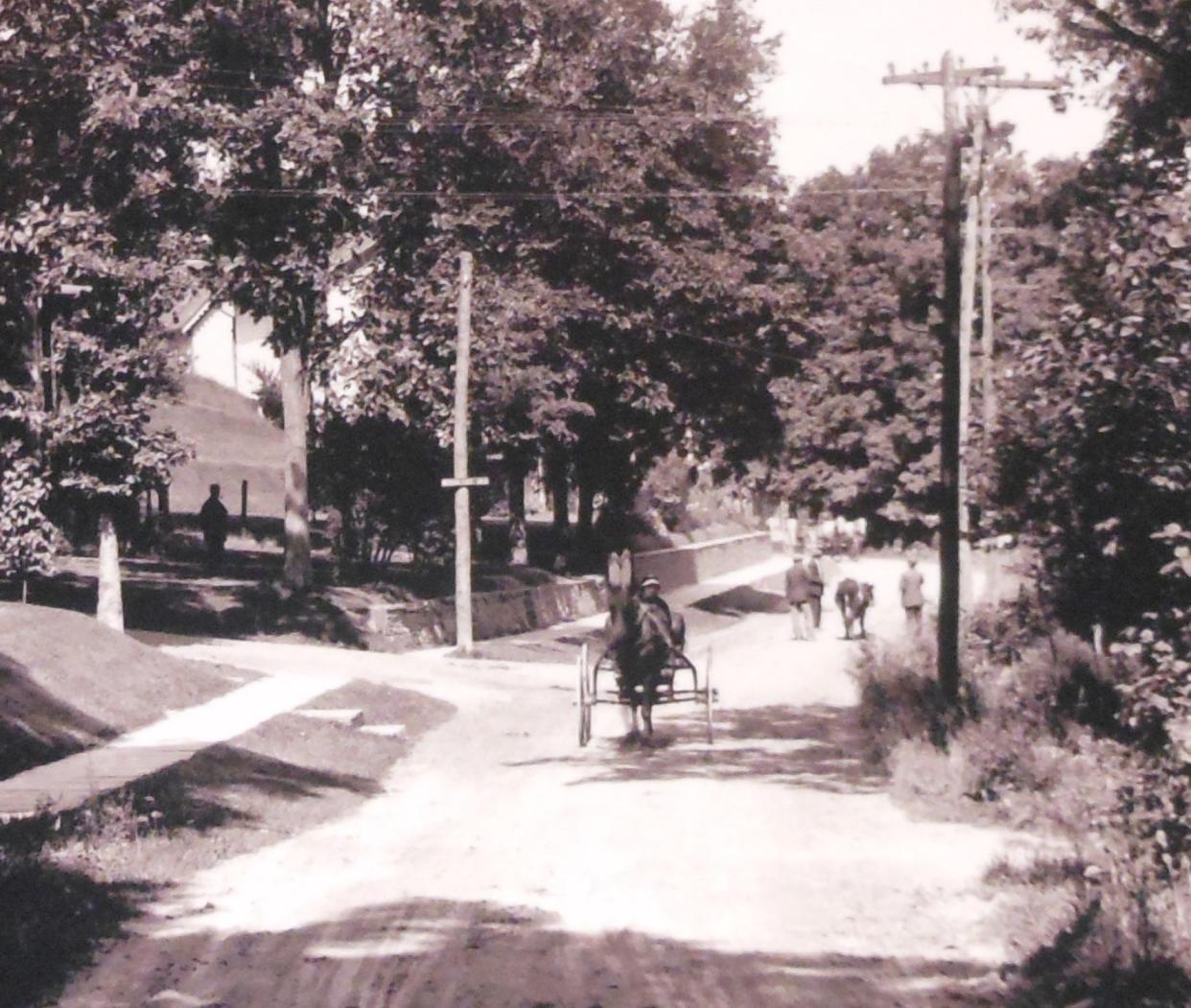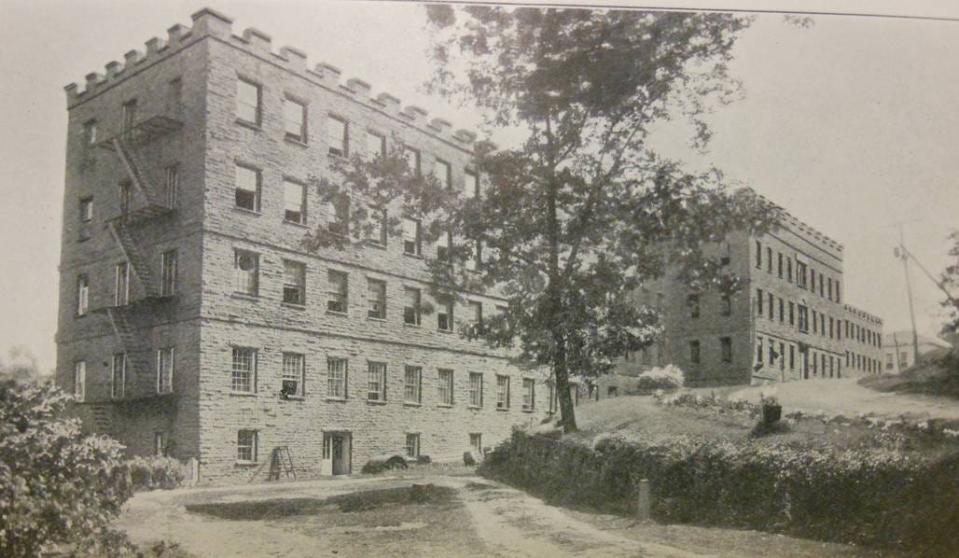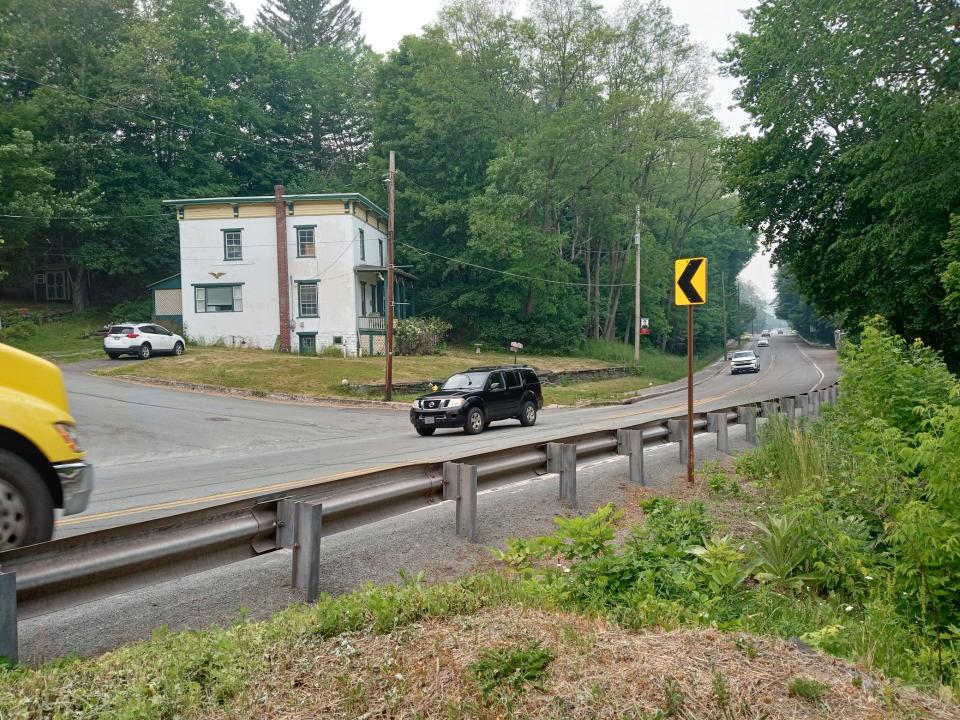Local history: When Hawley's 'morning rush hour' featured cows, horses, wagons

Morning rush hour in Hawley, Pa. was quite different at the dawn of the 20th century, as shown in a scene captured by renowned Hawley photographer Louis Hensel one summer morning around 1900-1910 on Bellemonte Avenue, what is today Route 6.
Heading down the street, towards downtown, are three men on foot leading a cow. They are taking up the whole road but will soon have to move over. In the distance rounding the bend is a team of horses pulling a wagon. Ahead of the team in the foreground we see a man in an open buggy, pulled by a long-eared donkey.
Bellemonte Avenue is dirt-surfaced and shows many tracks of wagon or buggy wheels. Sunshine casts shadows of the lush trees lining the residential street. At left is the intersection with Woodland Avenue. (High magnification verifies this on the street sign.)
Man with a pipe
Can you find an onlooker? Standing, watching the world go by in the shadow of the trees on the left, is a large fellow wearing a hat and smoking a pipe!
Some research reveals this might be Charles Schumann.
Old maps show the corner to be 254 Bellemonte Ave. Vintage Hawley street directories list Charles and Louise Schumann living there. Census records at Ancestry.com and old newspaper articles found at Newspapers.com reveal more about who this gentleman with the pipe may be.
He was born Feb. 6, 1863, at South Sterling, Wayne County, to Leonard and Philemina Schumann, German immigrants.
In June of 1890, Charles was married to Louise Glass, a daughter of German immigrants. They made their home on Wangum Avenue near River Street in Hawley. Charles worked as a teamster, a driver of draft animals, for a local silk mill.
The 1900 census lists them raising their two children, George, age 7, and Earl, age 5. By 1910, they were living on Erie Avenue. He was likely employed at Bellemonte Silk Mill, just up the road.
The Bellemonte Silk Mill, one of Hawley's most recognized landmarks and now known as Hawley Silk Mill, was erected in 1880. Made of bluestone and lined with a castle-like roof, the factory employed hundreds of people, mostly women and children as young as 8 in the early days. In 1914 under new ownership, the name was changed to Welwood Silk Mill. Erie Avenue was renamed Welwood Avenue.
By 1912, the family moved to Bellemonte Avenue, a short walk from the mill. Their fine home, hidden by the trees in the early picture, is plainly visible to motorists today.
Louise was treasurer of the Ladies Aid Society at St. Paul's Lutheran Church in Hawley.
Both sons served in the Army in World War I and were overseas, 1918-1919. Neither were injured.

George worked at Anke Knitting Mill and was also a silk worker. He was a weaver. He and his wife Anna lived at 207 Highland St. Their daughters Dolores and Dorothy were both married in July 1950, in separate ceremonies in Hawley. George lived until 1970.
Earl and his wife Ethel lived at 912 Oakland Ave. and worked at Welwood Silk Mill twisting threads. He was later a contractor and managed Schumann's Landing, Lake Wallenpaupack. They had a son, Eugene. Earl died in 1958.
Charles Schumann died July 10, 1925, age 62. His widow continued living at 254 Bellemonte. She died at age 73 on Nov. 30, 1940.
Changing times
Bellemonte Avenue is thought to have been built in time with the opening of the Bellemonte Silk Mill in 1880. The avenue does not appear on the 1872 Hawley map. The street headed straight to the factory’s front doors where it met in a "T" with Welwood Avenue. In 2010, street sections in front of the mill (which had become Castle Antiques), were transferred to the developers who repurposed the historic silk mill for various uses.
Before the 1960s, Bellemonte Avenue connected with Spring Street, which was curvy and steep before leveling out and reaching the beginning of Main Avenue. In 1962-1963, the state undertook a major road project to straighten Spring Street, create a rock cut and widen Bellemonte Avenue to accommodate increasing traffic and make it safer.
In Schumann's time, Bellemonte went straight to the junction with Welwood where one made a right turn to head down towards Pike County and Wilsonville, where in 1926 the broad Wallenpaupack river valley became a vast, new lake for hydroelectric power. When the state rebuilt Bellemonte, the curve was put in just ahead of the silk mill for traffic to connect Hawley and Lake Wallenpaupack via Route 6.

Horse vs. car
Despite the menagerie powering the vehicles in this early photo of Bellemonte, motor vehicles were not far behind. In fact, in the early 1900s they overlapped in Hawley as in communities across America, where newfangled automobiles were panicking the horses.
Local newspapers carried many accounts of runaway horses, often scared by horseless carriages. An incident in 1912 almost caused a big explosion — worthy of an early Fourth of July celebration.
The Hawley Times reported that a Mr. Moulton was working for the Hawley Coal Company Wednesday morning, July 3, 1912, and had a horse rented from Herbert Plum's livery. The horse was pulling a wagon carrying about 25 pounds of dynamite.
Moulton tied the horse to a post on Main Avenue, near the Syndicate building, 229 Main Ave. by Keystone Street, and went upstairs to the Elite Club rooms for a few moments. The exclusive men's club met on the second floor. The Syndicate became the Jos. Skier building in 1921.
An automobile came along and frightened the animal, causing the horse to break the line. "The animal did its best to set off the dynamite, as it turned every available corner before it was captured," the Times reported. "No one was injured and fortunately no damage was done."
Moulton was likely William Moulton, who was a co-partner of Hawley Coal Company.
In July 1910, Burgess (mayor) William C. Ames, a livery owner, posted 12-mile-an-hour speed limit signs on all roads entering the borough. He aimed to address the daring, reckless drivers of the new motorized marvels. He declared them a menace to lives and for raising dust (streets were not paved until the 1920s).
William H. Gibbs, who ran a cut-glass factory mill in the 1900s on Bellemonte Avenue, was said to have been the first person in Hawley to own an automobile, as early as 1902. His brother Charles built an automobile, the first in Honesdale.
Also like in other towns, Hawley had many blacksmith shops and liveries through the years. There were even a couple of wheelwrights in town, makers of wagon wheels. There is more than one account of local blacksmiths in Hawley transitioning to fixing and servicing cars and trucks.
One of them was John J. Lewis Wegge, better known by his moniker, Booty Wegge. A colorful character by remembered accounts, Wegge had a blacksmith shop on Paupack Street into the 1920s but converted it into an automotive shop.
Schumann and his entire generation took for granted long-gone scenes like this one on Bellemonte. Reminders of the horse age, however, may be found on several of Hawley's residential streets, with bluestone hitching posts still standing along the curb.
This article originally appeared on Tri-County Independent: Local history: Hawley's 'morning rush hour' when horses ruled the road

